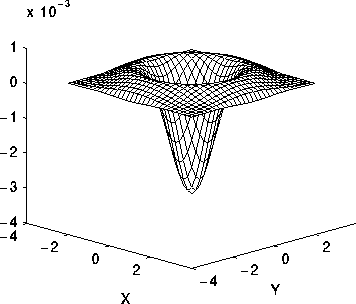This was something that confused me too, and it wasn't until I had to do the same as you for a uni project that I understood what you were supposed to do with the formula!
You can use this formula to generate a discrete LoG filter. If you write a bit of code to implement that formula, you can then to generate a filter for use in image convolution. To generate, say a 5x5 template, simply call the code with x and y ranging from -2 to +2.
This will generate the values to use in a LoG template. If you graph the values this produces you should see the "mexican hat" shape typical of this filter, like so:

You can fine tune the template by changing how wide it is (the size) and the sigma value (how broad the peak is). The wider and broader the template the less affected by noise the result will be because it will operate over a wider area.
Once you have the filter, you can apply it to the image by convolving the template with the image. If you've not done this before, check out these few tutorials.
java applet tutorials more mathsy.
Essentially, at each pixel location, you "place" your convolution template, centred at that pixel. You then multiply the surrounding pixel values by the corresponding "pixel" in the template and add up the result. This is then the new pixel value at that location (typically you also have to normalise (scale) the output to bring it back into the correct value range).
The code below gives a rough idea of how you might implement this. Please forgive any mistakes / typos etc. as it hasn't been tested.
I hope this helps.
private float LoG(float x, float y, float sigma)
{
// implement formula here
return (1 / (Math.PI * sigma*sigma*sigma*sigma)) * //etc etc - also, can't remember the code for "to the power of" off hand
}
private void GenerateTemplate(int templateSize, float sigma)
{
// Make sure it's an odd number for convenience
if(templateSize % 2 == 1)
{
// Create the data array
float[][] template = new float[templateSize][templatesize];
// Work out the "min and max" values. Log is centered around 0, 0
// so, for a size 5 template (say) we want to get the values from
// -2 to +2, ie: -2, -1, 0, +1, +2 and feed those into the formula.
int min = Math.Ceil(-templateSize / 2) - 1;
int max = Math.Floor(templateSize / 2) + 1;
// We also need a count to index into the data array...
int xCount = 0;
int yCount = 0;
for(int x = min; x <= max; ++x)
{
for(int y = min; y <= max; ++y)
{
// Get the LoG value for this (x,y) pair
template[xCount][yCount] = LoG(x, y, sigma);
++yCount;
}
++xCount;
}
}
}

